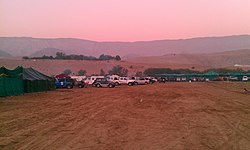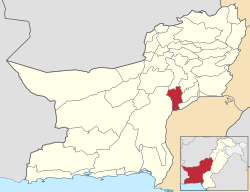Jhal Magsi District
This article needs additional citations for verification. (October 2017) |
Jhal Magsi District
ضلع جھل مگسی | |
|---|---|
 Panorama of Jhal Magsi | |
 Map of Balochistan with Jhal Magsi District highlighted | |
| Country | |
| Province | |
| Division | Nasirabad |
| Headquarters | Jhal Magsi |
| Government | |
| • Type | District Administration |
| • Deputy Commissioner | N/A |
| • District Police Officer | N/A |
| • District Health Officer | N/A |
| Area | |
| • Total | 3,615 km2 (1,396 sq mi) |
| Population (2017)[1] | |
| • Total | 148,900 |
| • Density | 41/km2 (110/sq mi) |
| Time zone | UTC+5 (PST) |
| Number of Tehsils | 2 |
Jhal Magsi District (Urdu: ضلع جھل مگسی) is a district in central Balochistan in Pakistan.[2] Previously part of Kachhi District, it was established as a district of its own in December 1991 and after a brief period in which it was known as Kachhi (the remainder of the old Kachhi district being renamed to Bolan), its name was changed to Jhal Magsi in May 1992.[3] The district is named after the town of Jhal, seat of the Magsi tribe, the major Baloch tribe within the district.[4] Historically, the Magsi tribe branched off from the earlier Lashari tribe.
The district has two main towns, Gandawah, the administrative centre and Jhal Magsi; and is divided into two subdivisions: Gandawah and Jhal Magsi. The City is also known for ancient places and tourist attractions like Peer Chattal Shah Noorani, Taj Mahal of Balochistan (Moti Gohram Tomb), Moola River, Peer Lakha and more.
Demographics[edit]
At the time of the 2017 census the district had a population of 148,900, of which 76,726 were males and 72,173 females. Rural population was 141,085 (94.75%) while the urban population was 7,815 (5.25%). The literacy rate was 23.46% - the male literacy rate was 31.87% while the female literacy rate was 14.60%. Islam was the predominant religion with 99.19%, while Hindus are 0.80% of the population.[1]
At the time of the 2017 census, 76.32% of the population spoke Sindhi, 14.33% Balochi, 5.67% Saraiki and 3.29% Brahui as their first language.[1]
Administrative divisions[edit]
Jhal Magsi District is administratively divided into two tehsils, Jhal Magsi and Gandawah; with one sub tehsil (Mirpur). Both subdivisions have a different administrative history.
It had nine Union Council in 2012, but last year four Union Council were added by the Local Government Department at recommendation of Deputy Commissioner/Delimitation Officer. Namely, the union councils of Jhal Magsi District are as under:
- Gandawah Tehsil
- Union Council Gandawah
- Union Council Khari
- Union Council Patri
- Mirpur Sub Tehsil
- Union Council Mirpur
- Jhal Magsi Tehsil
- Union Council Jhal Magsi
- Union Council Hathiari
- Union Council Panjuk
- Union Council Kot Magsi
- Union Council Barija
- Union Council Mat Sindhur
- Union Council Safrani
- Union Council Saifabad
- Union Council Akbarabad
Education[edit]
According to the Pakistan District Education Rankings 2017, district Jhal Magsi is ranked at number 108 out of the 141 ranked districts in Pakistan on the education score index. This index considers learning, gender parity and retention in the district.
Literacy rate in 2014–15 of population 10 years and older in the district stood at 25% whereas for females it was only 11%.[5]
Post primary access is a major issue in the district with 84% schools being at primary level. Compare this with high schools which constitute only 5% of government schools in the district. This is also reflected in the enrolment figures with 7,553 students enrolled in class 1 to 5 and only 118 students enrolled in class 9 and 10.
Gender disparity is another issue in the district. Only 33% schools in the district are girls’ schools. Access to education for girls is a major issue in the district and is also reflected in the low literacy rates for females.
Moreover, the schools in the district lack basic facilities. According to Alif Ailaan Pakistan District Education Rankings 2017, the district is ranked at number 142 out of the 155 districts of Pakistan for primary school infrastructure. At the middle school level, it is ranked at number 141 out of the 155 districts. These rankings take into account the basic facilities available in schools including drinking water, working toilet, availability of electricity, existence of a boundary wall and general building condition. More than 200 out of the 301 government schools in the district do not have electricity, toilet and a boundary wall. 139 schools do not have clean drinking water.
The main issues reported in Taleem Do! App for the district is the unavailability of teachers in schools.
References[edit]
- ^ a b c "District Wise Results / Tables (Census - 2017)". www.pbscensus.gov.pk. Pakistan Bureau of Statistics.
- ^ "Tehsils & Unions in the District of Jhal Magsi - Government of Pakistan". Archived from the original on 2012-03-26. Retrieved 2011-01-10.
- ^ PCO 2000, p. 1.
- ^ PCO 2000, p. 6.
- ^ Pakistan Bureau of Statistics (2016). Pakistan Social and Living Standards Measurement Survey 2014-15. [online] Islamabad: Government of Pakistan, p.111. Available at: http://www.pbs.gov.pk/sites/default/files//pslm/publications/PSLM_2014-15_National-Provincial-District_report.pdf [Accessed 6 Aug. 2018].
Bibliography[edit]
- 1998 District census report of Jhal Magsi. Census publication. Vol. 72. Islamabad: Population Census Organization, Statistics Division, Government of Pakistan. 2000.
External links[edit]
- Articles needing additional references from October 2017
- All articles needing additional references
- Articles with short description
- Short description with empty Wikidata description
- Pages using infobox settlement with bad settlement type
- Pages using infobox settlement with no coordinates
- Articles containing Urdu-language text
- Commons category link is defined as the pagename
- AC with 0 elements
- Coordinates not on Wikidata
- Jhal Magsi District
- Districts of Balochistan, Pakistan
